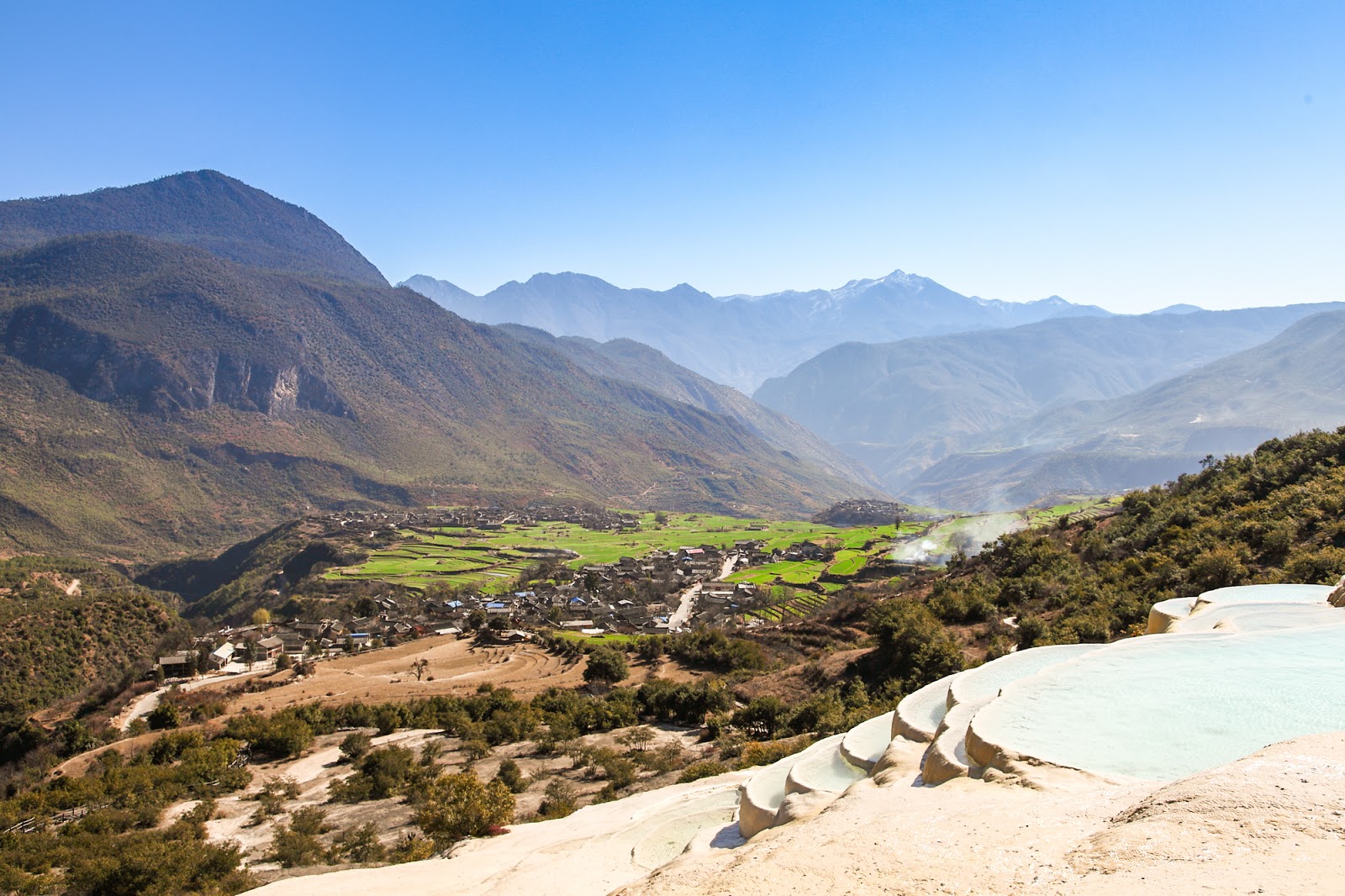
Shangri-La (bis Dezember 2001 Zhongdian) ist eine überwiegend von Tibetern und Naxi bewohnte kreisfreie Stadt im Nordwesten der chinesischen Provinz Yunnan und Regierungssitz des Autonomen Bezirks Dêqên der Tibeter. Shangri-La hat eine Fläche von 11.613 km², circa 130.000 Einwohner (Ende 2004) und liegt auf einer Höhe von 3200 m.
Shangri-La liegt auf dem Weg nach Tibet und wird deshalb von relativ vielen Touristen besucht, die unter anderem das hier gelegene Kloster Ganden Songtsenling (tib. dga' ldan srong btsan gling) besichtigen wollen.
Shangri-La ist ein fiktiver Ort in Tibet, wo Menschen in Frieden und Harmonie leben. Der sagenhafte Ort wurde 1933 im Roman Lost Horizon (dt. Der verlorene Horizont) des britischen Schriftstellers James Hilton beschrieben und steht seitdem als ein Synonym für das Paradies oder idealen Rückzugsort aus dem Weltgeschehen.[1]
香格里拉市(藏语:སེམས་ཀྱི་ཉི་ཟླ་གྲོང་ཁྱེར།,威利:Sems kyi nyi zla grong khyer)是中华人民共和国云南省迪庆藏族自治州下辖的一个县级市,亦是该州的首府。原名中甸县(藏语:རྒྱལ་ཐང་རྫོང་།,藏语拼音:Gyaitang Zong,威利:rgyal thang rdzong)。位于云南省西北部,是滇、川及西藏三省区交汇处,也是世界遗产“三江并流”腹地。
香格里拉(英语:Shangri-La)为一个虚构地名,最早出现在1933年英国小说家詹姆斯·希尔顿的小说《消失的地平线》中。这是一个小型村庄,神秘而和谐,位于昆仑山脉西方,被群山包围,由一个藏传佛教僧院统治。在小说中,这个村庄的居民,长生不老,过着快乐的生活。在这部小说出现后,这个名称被当成是世外桃源与乌托邦的同义词。
詹姆斯·希尔顿创造的这个故事,被认为可能源自于西藏香巴拉传说。
シャングリラ市(シャングリラし、チベット語:སེམས་ཀྱི་ཉི་ཟླ་གྲོང་ཁྱེར།、ワイリー方式:Sems kyi nyi zla grong khyer、中文表記: 香格里拉市、英文表記: Shangri-La City)は、中華人民共和国雲南省デチェン・チベット族自治州に位置する県級市。チベットではカム地方南部にあたる。自治州の州政府の所在地であり、市政府は建塘鎮に位置している。デチェン・チベット族自治州を構成する2行政区(徳欽県、維西リス族自治県)と共に国家級貧困県に指定されている。
チベット語でギャルタンと称され、チベット文化圏の南東端にあたり、北は徳欽(ジョル)、南は麗江を連絡する滇蔵公路における要衝となっている。ソンツェリン寺や虎跳峡が有名。また獰猛な性格で知られるチベット犬の産地でもある。 シャングリラ(英語: Shangri-La)は、イギリスの作家ジェームズ・ヒルトンが1933年に出版した小説『失われた地平線』に登場する理想郷(ユートピア)の名称。ここから転じて、一般的に理想郷と同義としても扱われている。
Shangri-La or Xianggelila, is a county-level city in Northwestern Yunnan Province, People's Republic of China and is the location of the seat of the Diqing Tibetan Autonomous Prefecture, bordering Sichuan to the northwest, north, and east.
Shangri-La is a fictional place described in the 1933 novel Lost Horizon by British author James Hilton. Hilton describes Shangri-La as a mystical, harmonious valley, gently guided from a lamasery, enclosed in the western end of the Kunlun Mountains. Shangri-La has become synonymous with any earthly paradise, particularly a mythical Himalayan utopia – an enduringly happy land, isolated from the world. In the novel, the people who live at Shangri-La are almost immortal, living hundreds of years beyond the normal lifespan and only very slowly aging in appearance. The name also implies an exoticized Orientalist perspective.
In the ancient Tibetan scriptures, the existence of seven such places are mentioned as Nghe-Beyul Khembalung.[1] Khembalung is one of several beyuls (hidden lands similar to Shangri-La) believed to have been created by Padmasambhava in the 9th century as idyllic, sacred places of refuge for Buddhists during times of strife (Reinhard, 1978).
La ville-district de Shangri-La (chinois : 香格里拉市 ; pinyin : ; tibétain : སེམས་ཀྱི་ཉི་ཟླ་གྲོང་ཁྱེར།, Wylie : Sems kyi nyi zla grong khyer, THL : semkyi nyida drongkhyer) est une subdivision administrative de la province du Yunnan en Chine. Le bourg de Jiàntáng (建塘镇), situé sur son territoire est le chef-lieu de la préfecture autonome tibétaine de Diqing. Shangri-La est un lieu imaginaire décrit dans le roman Lost Horizon (titre traduit en français : Les Horizons perdus), écrit par James Hilton en 1933, et adapté au cinéma par Frank Capra en 1937 (Les Horizons perdus).
Shangri-La (香格里拉市S, XiānggélǐlāP) è una città-contea della Cina, situata nella provincia di Yunnan e amministrata dalla prefettura autonoma tibetana di Dêqên. Shangri-La è un luogo immaginario descritto nel romanzo Orizzonte perduto di James Hilton del 1933.
Shangri-La (chino: 香格里拉, pinyin: Xiānggélǐlā, tibetano:སེམས་ཀྱི་ཉི་ཟླ་གྲོང་ཁྱེར wylie:Sems kyi nyi zla grong khyer), antiguamente conocida como Zhongdian (中甸, Zhōngdiàn) es una ciudad-condado bajo la administración directa de la Prefectura autónoma de Dêqên. Situada al noroeste de la provincia de Yunnan, en la República Popular China, la mayoría de los habitantes son de etnia tibetana aunque también se hay miembros Naxi, Lisu y Yi.
Como sede de gobierno, Shangri-La es el centro político, económico, cultural, tecnológico, financiero y de información de la prefectura autónoma de Dêqên.
En el año 2002, la ciudad fue renombrada como Shangri-La en honor al novelista James Hilton y a su novela Horizontes perdidos. El cambio de nombre supuso un importante aumento en el número de turistas que visitaron la ciudad. A pesar de esta mejora económica, se calcula que un 60% de los habitantes de la ciudad y de su área de influencia viven por debajo del umbral de la pobreza.
En lengua tibetana, el nombre de la ciudad es Gyelthang. Está situada a una altura de 3380 metros sobre el nivel del mar, rodeada de montañas y de lagos alpinos. Se ha convertido en uno de los puntos de partida de los viajes con destino al Tíbet.
En la zona se encuentran los tres ríos paralelos de las Áreas protegidas de Yunnan, declarados en el año 2003 Patrimonio de la Humanidad por la Unesco.
Dukezong, una de las poblaciones más turísticas de este territorio debido a su atractivo centro histórico con abundantes edificaciones construidas principalmente en madera, sufrió un devastador incendio que comenzó la noche del 10 de enero de 2014 y que provocó la destrucción de la práctica totalidad del rico patrimonio arquitectónico de ese municipio, además del desplazamiento de más de 2600 habitantes.
Shangri-La es el topónimo de un lugar ficticio, descrito en la novela Horizontes perdidos (Lost Horizon), publicada en 1933 por su creador, el británico James Hilton; el nombre trata de evocar el imaginario exótico de Oriente. Por extensión, el término se aplica para describir cualquier paraíso terrenal, pero sobre todo a una utopía del Himalaya: una tierra de felicidad permanente, aislada del mundo exterior.
En Horizontes perdidos, se describe a Shangri-La como un valle místico y armonioso, enclavado en el extremo occidental de las Montañas Kunlun; las personas que viven en Shangri-La son casi inmortales, viven cientos de años más que el resto de los seres humanos y envejecen muy lentamente.
En las antiguas escrituras tibetanas, la existencia de siete de esos lugares se menciona como Nghe-Beyul Khembalung.1 Khembalung es uno de los beyul —tierras ocultas similares a Shangri-La— creados, según la tradición, por Padmasambhava en el siglo IX como refugios idílicos y sagrados para los budistas en tiempos de conflicto.
Шангри-Ла (кит. упр. 香格里拉, пиньинь Xiānggélǐlā, палл. Сянгэлила, тиб. རྒྱལ་ཐང་རྫོང་, Gyalthang) — городской уезд Дечен-Тибетского автономного округа провинции Юньнань КНР. Шангри-Ла (англ. Shangri-La) — вымышленная страна, описанная в в 1933 году в романе писателя-фантаста Джеймса Хилтона «Потерянный горизонт». По мнению некоторых исследователей, Шангри-Ла Хилтона является литературной аллегорией вымышленной страны Шамбала. Название «Шангри-Ла», скорее всего, происходит от тибетского ཞང་, «Шанг» (район У-Цанга к северу от Ташилунпо[1]) + རི, «ри» (гора) + ལ, «ла» (горный перевал) = перевал горы Шанг.









